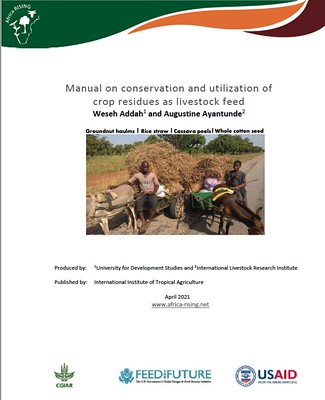Transforming crop residues into a precious feed resource for small ruminants in northern Ghana
Common crop residues fed to ruminants in northern Ghana include groundnut and cowpea haulms, rice straw, cottonseed and cassava peels.

In the crop-livestock farming systems of northern Ghana, it is estimated that small ruminants (mostly goats and sheep) are a source of livelihood for approximately 70% of the region’s inhabitants. But poor husbandry practices, key among them ad-hoc feeding, have hampered the productivity and general well-being of small ruminants. Seasonal feed scarcity is an undesirable norm.
In the wet season, small ruminants are mostly tethered by smallholders to stop them from making destructive forays into farmer’s fields where food crops are understandably ‘higher priority’. While in the dry season, they are finally let free to roam, but at this time there is usually an obvious and quick decline in the quality and quantity of natural pasture.
Having supplemental feed to keep the small ruminants healthy and sufficiently nourished is therefore a necessity for the majority of smallholders in northern Ghana who depend on these animals as a form of ‘insurance’ in the event of crop failure.

Over the past five years, Africa RISING partners from the International Livestock Research Institute (ILRI) and Ghana’s University for Development Studies (UDS) have been collaboratively working with farmers in the north of the country to validate the best methods for conserving common and locally available crop residues to ensure nutritionally effective supplemental feeding for small ruminants.
Led by Addah Wesseh and Augustine Ayantunde, the team has published a manual on the processes for conserving and using crop residues as livestock feed. The publication covers the processes for collecting, drying and ensiling (long-term storage) the four main crop residues found in the northern Ghana region – groundnut haulms, rice straw, cassava peels and whole cottonseed.
‘We have trained farmers and extension officers on the processes described in the manual. But it is critical that these lessons are documented for easy reference even by development workers in the region and other players who are carrying out small ruminant interventions in these communities,’ explains Wesseh, who is professor of ruminant nutrition at UDS.
Stressing the consequent need for all smallholders in the region to adopt the practice of using crop residues as feed, Ayantunde, principal livestock scientist at ILRI, explains the paradox many farmers are likely to face in embracing the use of crop residues.

‘Using crop residues as livestock feed has economic implications for small ruminant farmers because the animals gain weight during the rainy season when prices are ironically low, but lose weight during the dry season when the market value for meat is relatively higher due to increased social activities like religious festivals.’
As the impacts of climate change become more adverse, strategies to increase livestock farmers’ resilience must include those supporting crop-livestock integration. Improved access and availability of quality feed resources helps to respond to a significant part of the problem. Other elements that also have to be addressed and which Africa RISING has been addressing include integration of improved animal feeding with better veterinary care as well as introduction of technologies that reduce wastage of the scarce feed resources such as feed troughs.




